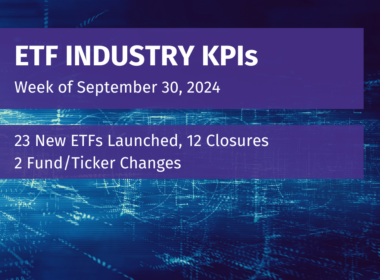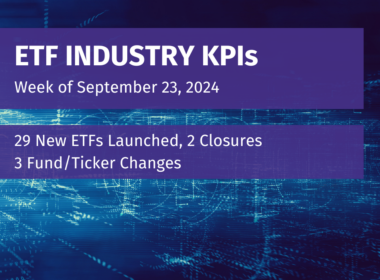With interest rates having soared over the past 18 months, the income environment has greatly improved for investors even though the path to getting there was sometimes rough. One of the popular strategies for really kickstarting your income stream is covered call writing. Kevin Simpson, Founder of Capital Wealth Planning and manages a pair of covered call ETFs, sees opportunities and challenges in the space today and joins the ETF Think Tank to give his thoughts on the current landscape.
Simpson’s strategies are built around high-quality companies rather than broad indexes. He simply targets companies that generate EBITDA and distribute cash flow to shareholders. While valuations and fundamentals are important considerations, Simpson believes that if you own companies like this over the long-term, the compounding effect will do wonderfully. Above all else, he primarily focuses on companies that are profitable and pay dividends.
Simpson’s company began developing a track record back in 2007 through separately managed accounts. He notes that he happened to hit at the right time in 2008 because they were able to buy inexpensive insurance before it was necessary. He lost 13-14%, but that was great, relatively speaking. In 2016, DIVO was launched, but it was a long, hard road to success. Most ETFs don’t become successful until year 3 and Simpson says that his company started to hit somewhere between years 3 and 5. It’s a grind with a lot of work.
Regarding Simpson’s covered call strategies specifically, they closely monitor their positions on daily basis and prefer out-of-the-money calls where expiration is around 30 days. Generally, he starts with calls that are 5% out-of-the-money. However, when the VIX barely generates a heartbeat and option premiums are low, he may be more cautious about entering positions because writing calls on stocks that are down 15-20% could screw them up with even a modest bounce. Simpson may try to write a 12% OTM call in a situation like that and the premium may still be good because volume is probably high. He looks at it as tactical covered call writing.
Dividend stocks have been out of favor, but has the Fed put them back in the spotlight? Simpson argues that there’s a recency bias, but dividend investing tends to work over time. People might pay up for growth, but dividends tend to work. The disparity between the performance of dividend payers vs. non-dividend payers hasn’t been this large since 2009.
Other key takeaways:
- Simpson starts by focusing solely on the S&P 100. Since he’s looking at dividend growth, the potential universe boils down to 75-100 names, of which 25-30 will make it in the ETF portfolios.
- What is the advantage to an SMA over an ETF? An SMA costs very little operationally. Institutions and family offices still think there’s something special about them having an SMA. SMAs allow for some customization.
- Not all dividend cuts are bad (e.g., Disney), but they are most of the time. Simpson generally avoids the risk and stays away from them.
- Until the tech improves, Simpson doesn’t see direct indexing really taking off. We had a 0% interest rate environment, and it was awesome, but the need for direct indexing is less in a normal world as it was during the previous low-rate environment. It’ll be more challenging to generate tax losses to harvest than it is with ETFs.
- Stocks with higher volatility generally present better covered call opportunities and vice versa. Tech generally makes for a better opportunity, but a lot of them don’t pay dividends so they’re not within their scope.
You can watch a replay of this virtual happy hour on our YouTube channel here. While there, subscribe to our channel to stay up to date on our latest content.
Disclosure
All investments involve risk, including possible loss of principal.
The material provided here is for informational purposes only and should not be considered an individualized recommendation or personalized investment advice. The investment strategies mentioned here may not be suitable for everyone. Each investor needs to review an investment strategy for his or her own particular situation before making any investment decision.
All expressions of opinion are subject to change without notice in reaction to shifting market conditions. Data contained herein from third party providers is obtained from what are considered reliable sources. However, its accuracy, completeness or reliability cannot be guaranteed.
Examples provided are for illustrative purposes only and not intended to be reflective of results you can expect to achieve.
The value of investments and the income from them can go down as well as up and investors may not get back the amounts originally invested, and can be affected by changes in interest rates, in exchange rates, general market conditions, political, social and economic developments and other variable factors. Investment involves risks including but not limited to, possible delays in payments and loss of income or capital. Neither Toroso nor any of its affiliates guarantees any rate of return or the return of capital invested. This commentary material is available for informational purposes only and nothing herein constitutes an offer to sell or a solicitation of an offer to buy any security and nothing herein should be construed as such. All investment strategies and investments involve risk of loss, including the possible loss of all amounts invested, and nothing herein should be construed as a guarantee of any specific outcome or profit. While we have gathered the information presented herein from sources that we believe to be reliable, we cannot guarantee the accuracy or completeness of the information presented and the information presented should not be relied upon as such. Any opinions expressed herein are our opinions and are current only as of the date of distribution, and are subject to change without notice. We disclaim any obligation to provide revised opinions in the event of changed circumstances.
The information in this material is confidential and proprietary and may not be used other than by the intended user. Neither Toroso or its affiliates or any of their officers or employees of Toroso accepts any liability whatsoever for any loss arising from any use of this material or its contents. This material may not be reproduced, distributed or published without prior written permission from Toroso. Distribution of this material may be restricted in certain jurisdictions. Any persons coming into possession of this material should seek advice for details of and observe such restrictions (if any).












